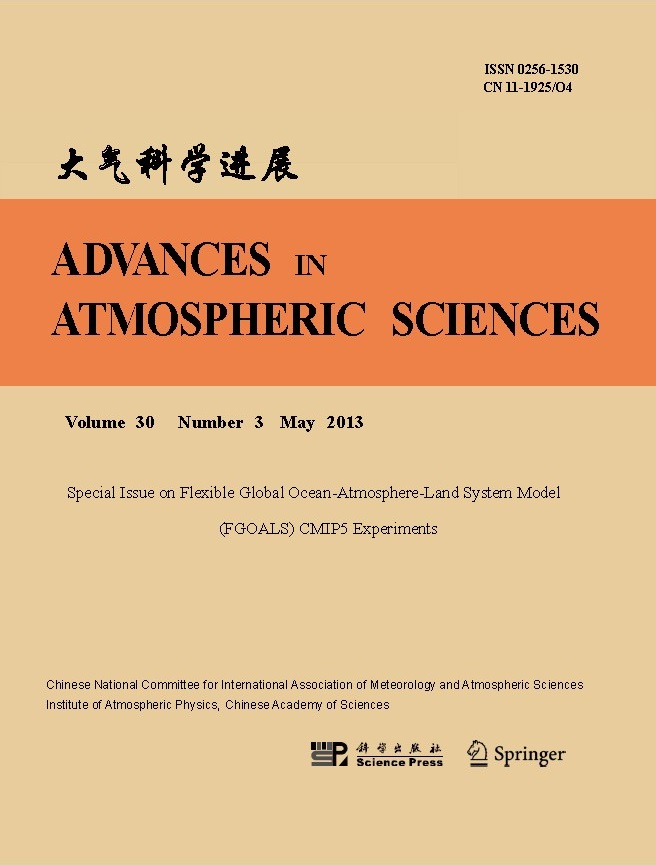| [1] |
Li Chongyin, Han-Ru Cho, Jough-Tai Wang,
2002: CISK Kelvin Wave with Evaporation-Wind Feedback and Air-Sea Interaction A Further Study of Tropical Intraseasonal Oscillation Mechanism, ADVANCES IN ATMOSPHERIC SCIENCES, 19, 379-390.
doi: 10.1007/s00376-002-0073-1
|
| [2] |
YANG Jing, BAO Qing, WANG Xiaocong,
2013: Intensified Eastward and Northward Propagation of Tropical Intraseasonal Oscillation over the Equatorial Indian Ocean in a Global Warming Scenario, ADVANCES IN ATMOSPHERIC SCIENCES, 30, 167-174.
doi: 10.1007/s00376-012-1260-3
|
| [3] |
PU Shuzhen, ZHAO Jinping, YU Weidong, ZHAO Yongping, YANG Bo,
2004: Progress of Large-Scale Air-Sea Interaction Studies in China, ADVANCES IN ATMOSPHERIC SCIENCES, 21, 383-398.
doi: 10.1007/BF02915566
|
| [4] |
P.C. Chu,
1988: AN INSTABILITY THEORY OF AIR-SEA INTERACTION FOR COASTAL UPWELLING, ADVANCES IN ATMOSPHERIC SCIENCES, 5, 277-286.
doi: 10.1007/BF02656752
|
| [5] |
Zhang Renhe, Chao Jiping,
1993: Unstable Tropical Air-Sea Interaction Waves and Their Physical Mechanisms, ADVANCES IN ATMOSPHERIC SCIENCES, 10, 61-70.
doi: 10.1007/BF02656954
|
| [6] |
Li Chongyin, Liao Qinghai,
1996: Behaviour of Coupled Modes in a Simple Nonlinear Air-Sea Interaction Model, ADVANCES IN ATMOSPHERIC SCIENCES, 13, 183-195.
doi: 10.1007/BF02656861
|
| [7] |
Shao Yongning, Chen Longxun,
1991: On Quasi-Biennial Oscillation in Air-Sea System, ADVANCES IN ATMOSPHERIC SCIENCES, 8, 11-22.
doi: 10.1007/BF02657361
|
| [8] |
Yan Jinghua, Chen Longxun, Wang Gu,
1988: THE PROPAGATION CHARACTERISTICS OF INTERANNUAL LOW-FREQUENCY OSCILLATIONS IN THE TROPICAL AIR-SEA SYSTEM, ADVANCES IN ATMOSPHERIC SCIENCES, 5, 405-420.
doi: 10.1007/BF02656787
|
| [9] |
FANG Yongjie, ZHANG Yaocun, HUANG Anning, LI Bo,
2013: Seasonal and Intraseasonal Variations of East Asian Summer Monsoon Precipitation Simulated by a Regional Air-Sea Coupled Model, ADVANCES IN ATMOSPHERIC SCIENCES, 30, 315-329.
doi: 10.1007/s00376-012-1241-6
|
| [10] |
Yan SUN, Fan WANG, De-Zheng SUN,
2016: Weak ENSO Asymmetry Due to Weak Nonlinear Air-Sea Interaction in CMIP5 Climate Models, ADVANCES IN ATMOSPHERIC SCIENCES, 33, 352-364.
doi: 10.1007/s00376-015-5018-6
|
| [11] |
Ngar-Cheung LAUInstitute of Environment, Energy and Sustainability, and Department of Geography and Resource Management, The Chinese University of Hong Kong, Shatin, N.T., Hong Kong,
2017: The Pioneering Works of Professor Duzheng YE on Atmospheric Dispersion, Tibetan Plateau Meteorology, and Air-Sea Interaction, ADVANCES IN ATMOSPHERIC SCIENCES, 34, 1137-1149.
doi: 10.1007/s00376-017-6256-6
|
| [12] |
REN Xuejuan, William PERRIE,
2006: Air-sea Interaction of Typhoon Sinlaku (2002) Simulated by the Canadian MC2 Model, ADVANCES IN ATMOSPHERIC SCIENCES, 23, 521-530.
doi: 10.1007/s00376-006-0521-4
|
| [13] |
ZHOU Xiaomin, LI Shuanglin, LUO Feifei, GAO Yongqi, Tore FUREVIK,
2015: Air-Sea Coupling Enhances the East Asian Winter Climate Response to the Atlantic Multidecadal Oscillation, ADVANCES IN ATMOSPHERIC SCIENCES, 32, 1647-1659.
doi: 10.1007/s00376-015-5030-x
|
| [14] |
Li Chongyin,
1998: The Quasi-Decadal Oscillation of Air-Sea System in the Northwestern Pacific Region, ADVANCES IN ATMOSPHERIC SCIENCES, 15, 31-40.
doi: 10.1007/s00376-998-0015-7
|
| [15] |
Zhou Tianjun, Yu Rucong, Li Zhaoxin,
2002: ENSO-Dependent and ENSO-Independent Variability over the Mid-Latitude North Pacific: Observation and Air-Sea Coupled Model Simulation, ADVANCES IN ATMOSPHERIC SCIENCES, 19, 1127-1147.
doi: 10.1007/s00376-002-0070-4
|
| [16] |
Charlie C. F. LOK, Johnny C. L. CHAN, Ralf TOUMI,
2022: Importance of Air-Sea Coupling in Simulating Tropical Cyclone Intensity at Landfall, ADVANCES IN ATMOSPHERIC SCIENCES, 39, 1777-1786.
doi: 10.1007/s00376-022-1326-9
|
| [17] |
LI Weibiao,
2004: Modelling Air-Sea Fluxes during a Western Pacific Typhoon: Role of Sea Spray, ADVANCES IN ATMOSPHERIC SCIENCES, 21, 269-276.
doi: 10.1007/BF02915713
|
| [18] |
Ting ZHANG, Jinbao SONG,
2018: Effects of Sea-Surface Waves and Ocean Spray on Air-Sea Momentum Fluxes, ADVANCES IN ATMOSPHERIC SCIENCES, 35, 469-478.
doi: 10.1007/s00376-017-7101-7
|
| [19] |
Yang Yan, Zhu Baozhen,
1995: The Dynamical Influence of Land-Sea Contrast and Sea Surface Temperature on Intraseasonal Oscillation in Tropical Atmosphere, ADVANCES IN ATMOSPHERIC SCIENCES, 12, 405-418.
doi: 10.1007/BF02657002
|
| [20] |
YANG Yun, WU Lixin,
2015: Changes of Air-sea Coupling in the North Atlantic over the 20th Century, ADVANCES IN ATMOSPHERIC SCIENCES, 32, 445-456.
doi: 10.1007/s00376-014-4090-7
|















 AAS Website
AAS Website 
 AAS WeChat
AAS WeChat 
 DownLoad:
DownLoad: